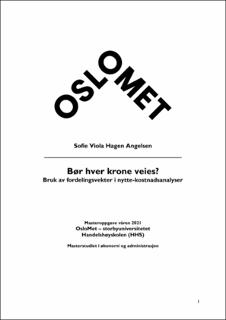| dc.contributor.advisor | Greaker, Mads | |
| dc.contributor.author | Angelsen, Sofie Viola hagen | |
| dc.date.accessioned | 2021-10-15T08:19:12Z | |
| dc.date.available | 2021-10-15T08:19:12Z | |
| dc.date.issued | 2021 | |
| dc.identifier.uri | https://hdl.handle.net/11250/2823215 | |
| dc.description.abstract | Samfunnsøkonomiske analyser brukes for å vurdere hvorvidt et prosjekt er samfunnsmessig
lønnsomt og bør gjennomføres eller ikke. Dersom den neddiskonterte summen av
prosjektets nytte- og kostnadsvirkninger (netto nåverdi) er positiv vil prosjektet ansees som
lønnsomt. Når man summerer nytte (inntektsøkninger) og kostnader så vil det som regel ikke
tas hensyn til hvem som blir påvirket av prosjektet. Er dette riktig ut fra økonomisk
velferdsteori? Folk har ulik marginalnytte av konsum, så en krone ekstra vil generelt ha større
nytteeffekt for de fattigste enn for de rike. Bør dette inkluderes i analysen?
I Norge anbefales at fordelingseffekter vurderes kvalitativt ved siden av den kvantitative delen
i nytte-kostnadsanalyser (NKA). Begrunnelsen er det såkalte Kaldor-Hicks kriteriet: et
prosjekt er lønnsomt dersom de totale inntektene øker, og en kan med en passende og mer
effektiv omfordeling i etterkant sørge for at ingen grupper får det verre (Potensiell Pareto
Forbedring). Imidlertid er det sjelden at en slik omfordeling faktisk skjer. Et alternativ er derfor
å inkludere fordelingseffekter direkte i en NKA, slik at en kroneendring for ulike individer
(grupper) som blir påvirket av prosjektet veies ulikt. Argumentasjonen mot dette er bl.a. at det
er for komplisert og krever for mye informasjon. Imidlertid fins det klare anbefalinger for
hvordan man kan inkludere fordelingseffekter i analysen og det meste av informasjonen vil
være tilgjengelig når man har beregnet effektene av prosjektet.
For å se på hvordan inkluderingen av fordelingsvekter endrer netto nåverdi har jeg tatt
utgangspunkt i to caser: Stad skipstunnel og en vindmøllepark. Stad skipstunnel er blitt
utredet flere ganger de tre siste tiårene, og analysen i oppgaven er basert på eksisterende
litteratur og NKA. Vindkraftverket er et semi-hypotetisk scenario som tar utgangspunkt i data
innhentet hovedsakelig fra NVE og tidligere studier om miljøkostnader ved vindkraft.
Stad skipstunnel er i utgangspunktet ikke lønnsomt, og bruken av fordelingsvekter vil ikke
endre på hovedkonklusjonen. Nytten tilfaller i første rekke rederier og shipping industrien med
relativt høy inntekt, og bruk av fordelingsvekter vil dermed kunne gjøre tunnelen enda mindre
lønnsom. For vindkraft vil bruken av fordelingsvekter gjøre at negative lokale miljøeffekter
tillegges noe høyere verdi. Samtidig er prosjektet delvis privateid, og inntekter vil tilfalle
grupper med relativt høy inntekt. Også i dette tilfellet vil også introduksjonen av
fordelingsvekter trekke ned lønnsomheten, og under andre og fortsatt realistiske
forutsetninger kan det endre konklusjonen om prosjektet bør gjennomføres eller ikke. | en_US |
| dc.description.abstract | Economic analyses are used to evaluate whether a project is socially profitable and should be implemented or not. If the discounted sum of the project’s costs and benefits (net present value) is positive, the project is considered profitable. When summing up the costs and benefits, one normally for does not take into consideration who is affected by the project. Is that in line with economic welfare theory? People have different marginal utility of consumption, so an extra dollar will generally have a larger welfare effect on the poor than on the rich. Should that be incorporated into the analysis?
In Norway it is recommended that distributional effects are assessed qualitatively alongside the quantitative part of a cost-benefits analysis (CBA). The justification is the Kaldor-Hicks principle: a project is profitable if the total income increases, and one may afterwards with an appropriate redistribution ensure that no groups are worse off (Potential Pareto Improvement). However, this redistribution rarely takes place. An alternative is thus to include distributional effects directly in a CBA, such that a dollar change for different individuals (groups) affected by the project is weighed differently. The argument against using distributional weights is that it is complicated and requires a lot of information. But there are clear recommendations on how to include such weights in the analysis, and most of the information needed is available when the effects of the project have been calculated.
To explore how including distributional weights changes net present value, I use to cases: Stad ship tunnel and a wind farm. Stad ship tunnel has been evaluated several times, and the analysis is based on existing literature. The wind farm is a semi-hypothetical scenario based on data obtained mainly from NVE as well as studies on environmental costs.
Stad ship tunnel is not profitable using ordinary CBA, and the use of distributional weights will not change the main conclusion. The benefits go primarily to the shipping industry with a relatively high income, and the use of distribution weights will thus make the tunnel even less profitable. For wind power, the use of distributional weights implies that negative local environmental effects are given a slightly higher value. At the same time, the project is partly privately owned, and the revenue will go to groups with relatively high income. Also in this case, the introduction of distribution weights will reduce profitability, and under realistic assumptions it may change the conclusion on whether the project should be carried out or not. | en_US |
| dc.language.iso | nob | en_US |
| dc.publisher | OsloMet - storbyuniversitetet | en_US |
| dc.subject | Nytte-kostnadsanalyse | en_US |
| dc.subject | Fordeling | en_US |
| dc.subject | Stad skipstunnel | en_US |
| dc.subject | Vindmølle | en_US |
| dc.title | Bør hver krone veies? Bruk av fordelingsvekter i nytte-kostnadsanalyser | en_US |
| dc.type | Master thesis | en_US |
| dc.description.version | submittedVersion | en_US |
